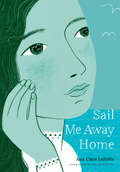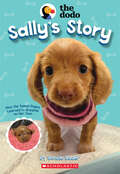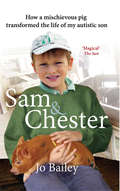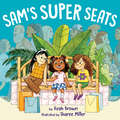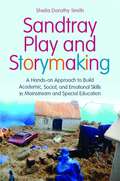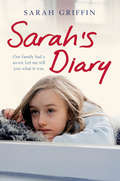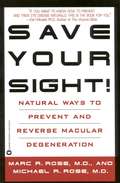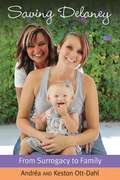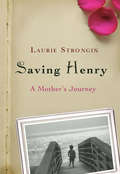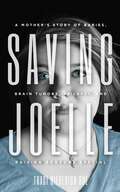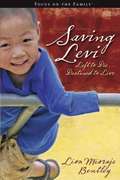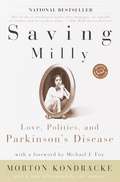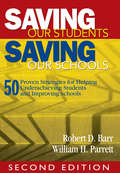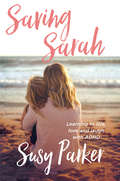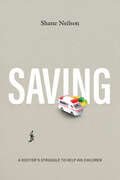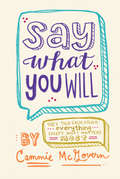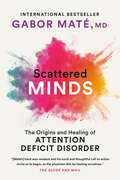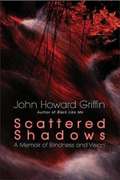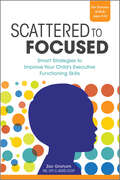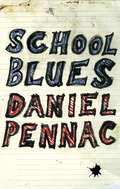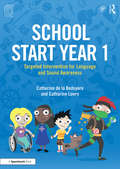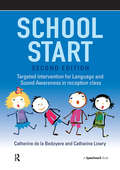- Table View
- List View
Sail Me Away Home (Show Me a Sign)
by Ann Clare LeZotteThis gripping, stand-alone story, set in the world of the award-winning Show Me a Sign and Set Me Free, completes a unique and unforgettable trilogy that centers the Deaf experience.As a young teacher on Martha's Vineyard, Mary Lambert feels restless and adrift. So when a league of missionaries invite her to travel abroad, she knows it's a once in a lifetime opportunity. Paris is home to a pioneering deaf school where she could meet its visionary instructors Jean Massieu and Laurent Clerc-and even bring back their methods to help advance formal deaf education in America!But the endeavor comes at a cost: The missionaries' plan to "save" deaf children is questionable at best-and requires Mary's support. What's more, the missionaries' work threatens the Wampanoag and other native peoples' freedom and safety. Is pursuing Mary's own goals worth the price of betraying her friends and her own values?So begins a feverish and fraught adventure, filled with cunning characters, chance encounters, and new friendships. Together with Show Me a Sign and Set Me Free, this stunning story will enrich your understanding of Deaf history and culture, and forever alter your perspective on ability and disability.
Sally's Sandcastles: Targeting the s Sound (Speech Bubbles 1)
by Melissa PalmerA day at the seaside sounds magical to Sally, who brings her bucket and spade for a sandcastle making adventure. This picture book targets the /s/ sound, and is part of Speech Bubbles 1, a series of picture books that target specific speech sounds within the story. The series can be used for children receiving speech therapy, for children who have a speech sound delay/disorder, or simply as an activity for children’s speech sound development and/or phonological awareness. They are ideal for use by parents, teachers or caregivers. Bright pictures and a fun story create an engaging activity perfect for sound awareness. Please see other titles in the series for stories targeting other speech sounds.
Sally's Story (The Dodo)
by Bonnie BaderThe true story of how one little puppy learned to breathe on her own -- as seen on The Dodo!When Sally was rescued, this tiny dachshund puppy couldn't eat or breathe without help. Sally had a feeding tube to give her food and medicine. And she had to stay inside a plastic bubble to get the extra oxygen she needed.But Sally was determined to breathe on her own. She practiced spending small amounts of time outside her bubble. Slowly but surely, Sally's lungs grew healthy and strong. With the love and support of those around her, Sally showed the world what it means to never give up!This story is perfect for middle-grade readers and includes eight-pages of full-color photos!
Sam and Chester: How a Mischievous Pig Transformed the Life of My Autistic Son
by Jo Bailey-MerrittWhen Sam Bailey-Merritt was just two years old, almost overnight he lost the ability to communicate or function. His mother, Jo, was at a loss as to what to do as she saw her son grow increasingly isolated and begin to suffer from uncontrollable meltdowns. Eventually, Sam was diagnosed with autism.Sam's condition continued to worsen and, just when Jo had all but given up hope of being able to help him, the family went on a day trip to a nearby miniature pig farm. Sam immediately bonded with a tiny ginger piglet called Chester, who stood sad and alone, apart from the rest of the litter. The connection between the boy and the animal was immediate and their unusual friendship blossomed from the moment the family brought Chester home. The tiny pig refused to leave Sam's side - it was as if he knew that Sam needed a friend. And, for the first time in five years, Jo saw her son really laugh.While Sam's confidence grew, Chester grew in a different way: the micro pig that was supposed to become the size of a Cocker Spaniel in fact ballooned to three times that size - with hilarious consequences for the family! Chester has turned Sam's life around. He now has the ability to communicate his feelings, make friends and is caring and kind towards others.Sam and Chester is the heart-warming story of how a teacup-sized ginger pig helped to transform the life of a boy with autism. It is the emotional story of a mother's fight to win back her son.
Sam's Super Seats
by Keah BrownA joyful picture book about a disabled girl with cerebral palsy who goes back-to-school shopping with her best friends, from #DisabledandCute creator and The Pretty One author Keah Brown.Sam loves herself, learning, and making her family and friends laugh. She also loves comfortable seats, including a graceful couch named after Misty Copeland and Laney, the sassy backseat of Mom&’s car. After a busy morning of rest, Sam and her friends try on cute outfits at the mall and imagine what the new school year might bring. It&’s not until Sam feels tired, and the new seat she meets isn&’t so super, that she discovers what might be her best idea all day. With hilarious, charming text by Keah Brown and exuberant illustrations by Sharee Miller, Sam&’s Super Seats celebrates the beauty of self-love, the power of rest, and the necessity of accessible seating in public spaces. Includes narrative description of art for those with low/limited vision.
Sandtray Play and Storymaking
by Sheila Dorothy SmithIntroducing sandtray play and storying into mainstream and special education classrooms can have an extremely enriching impact on the learning experience. When used effectively, it can create the climate for social, emotional and behavioural growth and incite bursts of creativity in students. Build a world in your sandtray; tell its story; record it; listen to your partner's story - these are the invitations to students in a sandtray play/narrative workshop. The benefits of such an approach are endless, from the positive, therapeutic effects of physically displaying emotions through sand worlds to the development of essential speaking, listening and writing skills when telling and recording sand world stories. This accessible and classroom-friendly book explains the thinking behind this unique approach and answers all the nuts-and-bolts questions of sandtray/narrative workshop setup. It offers a wealth of practical methods that can be applied to a wide spectrum of the student population and details real-life anecdotes and student work. This book is an invaluable handbook for teachers and school counselors looking to use play and storying as a way to develop core competencies in children with special educational needs and in the mainstream, and will also be of interest to play therapists, speech and language therapists and educational psychologists.
Sarah's Diary: An unflinchingly honest account of one family's struggle with depression
by Sarah Griffin'I was fourteen when I found my Dad trying to commit suicide in the garage. Sounds shocking doesn't it? But that was part of me, part of living with my Dad'Sarah's Diary is the very personal diary of Sarah Griffin - an ordinary teenage girl learning to deal with the ups and downs of family life. On the outside hers was like any other family, but behind closed doors lay a sad and lonely secret. Sarah's Dad had depression -- a condition we've all heard of but seldom discuss. Beautifully written, brutally honest, Sarah's story is compelling reading.
Save Me! A Young Woman's Journey through Schizophrenia to Health
by Judy LeeThe author describes growing up with an alcoholic mother and plunging into the drug culture during her years as a college student. After several LSD trips she found herself losing touch with reality, and was diagnosed as a paranoid schizophrenic. With the help of a "reality therapist" and her deep Christian faith she finally managed to rebuild her life.
Save Your Sight!: Natural Ways to Prevent and Reverse Macular Degeneration
by Michael R. Rose Marc R. RoseMacular degeneration, an affliction of progressive vision loss, is the leading cause of blindness in the United States. This remarkable volume shows how diet, nutritional supplements, exercise and certain lifestyle choices can halt, reverse, or even prevent the onslaught of this devastating disease.
Saving Delaney: From Surrogacy to Family
by Keston Ott-DahlSaving Delaney is the heartwarming true story of a special needs baby and the unconventional family who fought for her right to life. Andrea Ott-Dahl, who with her wife Keston Ott-Dahl has two other children, agreed to act as a pregnancy surrogate for a wealthy Silicon Valley couple. When pre-natal testing revealed the baby would be born with Down Syndrome, Andrea was urged to abort the child. Instead, the Ott-Dahls chose to adopt and raise the daughter they would call Delaney, navigating legal, medical and emotional challenges. Despite heart surgery and an array of other challenges, Delaney at age 3 is alive, thriving, and an inspiration to every loving parent on the planet.
Saving Henry: A Mother's Journey
by Laurie Strongin"A heartbreaking story, exquisitely told . . . Laurie Strongin's integrity, humanity, and wisdom are an inspiration to the rest of us."--David Shenk, author of The ForgettingSaving Henry is the eye-opening and inspiring story of how far a family will go to save the life of their child. Laurie Strongin's son Henry was born with a heart condition that was operable, but which proved to be a precursor for a rare, almost-always fatal illness: Fanconi anemia. Deciding to pursue every avenue that might provide a cure, Laurie and her husband signed on for a brand new procedure that combined in vitro fertilization with genetic testing to produce a baby without the disease, who could be a stem cell donor for Henry. As Laurie puts it: "I believe in love and science, nothing more and nothing less."Laurie and her husband endured nine failed courses of the procedure before giving up. But Saving Henry is also about hope. It is the story of Henry, the feisty little boy who loved Batman, Cal Ripken Jr., and root beer-flavored anesthesia, and who captivated everyone with his spunk and positive attitude. When the nurses came to take blood samples, Henry brandished his toy sword and said, "Bring it on!" When he lost his hair after a chemo treatment, he declared, "Hey, I look like Michael Jordan!"Laurie became a fervent advocate for stem cell research, working with policymakers and the scientific community to bring attention to Henry's case and to the groundbreaking research that could save many lives. Henry's courage and bravery inspired nurses, doctors, friends, and family. Saving Henry is the story of one family's search for a cure, and the long-lasting scientific impact their amazing little boy has had.
Saving Joelle: A Mother's Story of Babies, Brain Tumors, Epilepsy, and Raising Someone Special
by Traci Diederich RueIn Saving Joelle, a mother recounts the struggles faced by her oldest daughter, her family and herself. Little was known about their daughter's rare brain tumor, leading the parents to tirelessly search the world in hope of a cure. As if the tumor wasn't enough, their growing family struggled with multiple setbacks including other grim medical issues. Saving Joelle will take you through years of heart wrenching decisions made by this brave family and reflect on their continued journey to overcome each obstacle. Their story explores the meaning of love, hope, and their resilience in raising a child with special needs.
Saving Levi: Left to Die, Destined to Live
by Lisa Misraje BentleyA baby boy is found in a field in China. He has been burned over most of his body and left to die in is burial clothes. This is the story of an American famly running an orphanage for Chinese special-needs children. They recover the child from a chinese man. The Americans save him first in hospitals in China and then, through help from all over the world and their belief in God, bring the baby to the U.S. for treatment.
Saving Milly: Love, Politics, and Parkinson's Disease
by Morton KondrackeFrom the book: "Deeply affecting . . . Unforgettable . . . Kondracke seems to be a natural truth-teller, and the directness of his narrative, its demotic lack of interest in irony when confronted with the rudimentary facts of mortal illness, opens his reader's heart and engages his reader's mind." -The New Republic "This is Morton Kondracke's account of his wife's battle with Parkinson's disease and his own transformation from a self-described careerist with more drive than talent to a mensch who has achieved greatness in this one book alone. I finished it last night in tears." -RICHARD COHEN, The Washington Post "Morton's love for Milly has been unfailingly strong and steadfast ... in sickness and in health. His fierce devotion has inspired him to move mountains, and move scientists closer than ever to finding a cure for this cruel disease. We all must join together to fight for more money so we can save our most precious resource-the lives of those we love." -KATIE COURIC
Saving Our Students, Saving Our Schools: 50 Proven Strategies for Helping Underachieving Students and Improving Schools
by Robert Dale Barr William H. ParrettThis field-tested resource outlines effective approaches for improving student learning, proficiency, and achievement at all levels through learning-focused priorities, results-driven practices, and high academic expectations.
Saving Sarah: Learning to live, love and laugh with ADHD
by Susy ParkerSusy Parker's daughter, Sarah, was diagnosed with ADHD and Anxiety when she was just six years old. Months later she was also diagnosed with Oppositional Defiance Disorder (ODD). Saving Sarah charts her family's rollercoaster journey from diagnosis, through the consulting rooms of various specialists, their confusion over the conflicting medical advice they received and Susy's eventual decision to quit the medications and find her own way to save her daughter and their family. I am sharing Sarah's story to let other parents know that there can be another way and that miracles do happen, because a miracle happened to us. ADHD, it's just a different way to be. - Susy I think that the Doctors don't know what they are doing. Children are really scared, and the Doctors don't know what the children are actually capable of. When they know, they will see that they are beautiful children, and they don't need medication. - Sarah * Names have been changed to protect identity
Saving: A Doctor’s Struggle to Help His Children
by Shane Neilson“ Shane Neilson is a brilliant writer and his work deserves to be better known. There hasn' t been such a poignant and harrowing memoir of fatherhood in Canada since Ian Brown' s The Boy in The Moon.” – Karen Connelly, author of The Change RoomWhen his two-year-old son develops epilepsy, Shane Neilson and his wife, Janet, struggle to obtain timely care for him while at the same time navigating their young daughter' s diagnosis of childhood depression. His family' s journey through a sometimes inadequate and often uncaring medical system is informed by Shane' s personal history of bipolar disorder and his professional experience with disability as a practicing physician.
Say What You Will
by Cammie Mcgovern<P>John Green's The Fault in Our Stars meets Rainbow Rowell's Eleanor & Park in this beautifully written, incredibly honest, and emotionally poignant novel. Cammie McGovern's insightful young adult debut is a heartfelt and heartbreaking story about how we can all feel lost until we find someone who loves us because of our faults, not in spite of them. <P>Born with cerebral palsy, Amy can't walk without a walker, talk without a voice box, or even fully control her facial expressions. Plagued by obsessive-compulsive disorder, Matthew is consumed with repeated thoughts, neurotic rituals, and crippling fear. Both in desperate need of someone to help them reach out to the world, Amy and Matthew are more alike than either ever realized. <P>When Amy decides to hire student aides to help her in her senior year at Coral Hills High School, these two teens are thrust into each other's lives. As they begin to spend time with each other, what started as a blossoming friendship eventually grows into something neither expected, they realize that they tell each other everything--except the one thing that matters most.
Scattered Minds: The Origins and Healing of Attention Deficit Disorder
by Gabor MatéINTERNATIONAL BESTSELLER From renowned mental health expert and speaker Gabor Maté, MD, Scattered Minds explodes the myth of attention deficit disorder (ADD/ADHD) as genetically based—and offers real hope and advice for children and adults who live with the condition. In this breakthrough guide to understanding, treating, and healing attention deficit disorder, Dr. Gabor Maté, an adult with ADD and the father of three ADD children, shares information on: · The external factors that trigger ADD/ADHD · How to create an environment that promotes health and healing · Ritalin and other drugs · ADD in adults …and much more Attention Deficit Disorder (ADD/ADHD) has remained a controversial topic in recent years. Whereas other books on the subject describe the condition as inherited, Dr. Maté shows how our social and emotional environments play a key role in both the cause of and cure for the condition. In Scattered Minds, he describes the painful realities of ADD/ADHD and its effect on children as well as on careers and social paths in adults. While acknowledging that genetics may indeed play a part in predisposing a person toward ADD/ADHD, Maté moves beyond that to focus on the things we can control: changes in environment, family dynamics, and parenting choices. He draws heavily on his own experience with the disorder, as both an ADD sufferer and the parent of three diagnosed children. Providing a thorough overview of ADD/ADHD and its treatments, Scattered Minds is essential and life-changing reading for the millions of ADD/ADHD sufferers in North America today.
Scattered Shadows: A Memoir of Blindness and Vision
by John Howard GriffinThis extraordinary chronicle from the author of "Black Like Me" about his loss of sight is a powerful testament to the human spirit. Edited and introduced by Robert Bonazzi
Scattered to Focused: Smart Strategies to Improve Your Child's Executive Functioning Skills
by Zac GrishamThis book is filled with expert advice and actionable strategies that can help your smart but scattered 4-12-year-old child build the skills they need to thrive both at school and at home.Parenting a child who struggles with executive function—the skills that help us stay focused, manage our emotions, and plan ahead—can be a challenge, whether they have an official ADHD diagnosis. Set your child up for success with:Quick assessment tools—Better understand your child's level of executive function and learn what motivates them, for stronger communication and connection.Expert advice—Learn how to build confidence and autonomy in your smart but scattered child with research-based guidance for helping them practice self-control, manage time, follow routines, beat procrastination, and more.Common sense explanations—Explore how executive function works in clear, simple language, and then apply what you learned through fun activities like using code words and making memory boards.Build better habits and routines with our comprehensive parent guide, Scattered to Focused!
School Blues
by Daniel PennacDaniel Pennac has never forgotten what it was like to be a very unsatisfactory student, nor the day one of his teachers saved his life by assigning him the task of writing a novel. This was the moment Pennac realized that no-one has to be a failure for ever. In School Blues, Pennac explores the many facets of schooling: how fear makes children reject education; how children can be captivated by inventive thinking; how consumerism has altered attitudes to learning. Haunted by memories of his own turbulent time in the classroom, Pennac enacts dialogues with his teachers, his parents and his own students, and serves up much more than a bald analysis of how young people are consistently failed by a faltering system. School Blues is not only universally applicable, but it is unquestionably a work of literature in its own right, driven by subtlety, sensitivity and a passion for pedagogy, while embracing the realities of contemporary culture.
School Blues
by Daniel PennacDaniel Pennac has never forgotten what it was like to be a very unsatisfactory student, nor the day one of his teachers saved his life by assigning him the task of writing a novel. This was the moment Pennac realized that no-one has to be a failure for ever. In School Blues, Pennac explores the many facets of schooling: how fear makes children reject education; how children can be captivated by inventive thinking; how consumerism has altered attitudes to learning. Haunted by memories of his own turbulent time in the classroom, Pennac enacts dialogues with his teachers, his parents and his own students, and serves up much more than a bald analysis of how young people are consistently failed by a faltering system. School Blues is not only universally applicable, but it is unquestionably a work of literature in its own right, driven by subtlety, sensitivity and a passion for pedagogy, while embracing the realities of contemporary culture.
School Start Year 1: Targeted Intervention for Language and Sound Awareness (School Start)
by Catherine de la Bedoyere Catharine LowryThis highly practical resource is designed to be used with children who need additional help in developing communication skills in Year 1. It offers a carefully structured group intervention which can be delivered by teachers or teaching assistants and is designed to boost language and sound awareness skills School Start Year 1 includes: detailed advice on how to set up the programme and identify children who may benefit; a structured programme of 30 Language group sessions; a structured programme of 30 Sound Awareness group sessions; activities and learning objectives that link with the Primary curriculum; 56 resource templates that can be photocopied or downloaded from the website; templates to monitor each child’s objectives and an end of year evaluation. Activities are supported by colourful and original illustrations to engage children’s interest and are themed around topics such as animal antics, detective stories and the seaside. An additional 5 template sessions are provided which can be used to extend the programme into Year 2. The authors provide clear guidance on how to use the resources and include an FAQ section for schools, parents and Speech and Language Therapists. This latest resource is a follow on to the hugely popular School Start and Pre-School Start and has been successfully piloted in schools. This is an invaluable resource for primary school staff that encourages good collaborative practice between teachers, teaching assistants, inclusion co-ordinators, SENCOs, speech and language therapists and parents.
School Start: Targeted Intervention for Language and Sound Awareness in Reception Class, 2nd Edition (School Start)
by Catherine de la Bedoyere Cath LowryThis is a practical resource that can be used with children who need additional help in developing communication skills during the first year of school and is a follow-on from the hugely successful first edition. This second edition focuses primarily on a targeted group intervention, to boost the language and sound awareness skills of children entering reception class, who are delayed in these areas of communication. It also addresses aspects of attention, following instructions and social communication.School Start, aims to help children catch up so that they may be ready to access the learning environment of Year 1. It is an invaluable resource for teachers and teaching assistants that encourages good collaborative practice between schools, speech & language therapists, the SENCO and parents. The programme consist of: an initial six-week period so that educational staff may identify children of concern; a screening checklist to confirm the identification of those children a structured programme of 30 Language group sessions that teaching assistants will find quick and easy to follow, delivered once a week a structured programme of 30 Sound Awareness group sessions that teaching assistants will find quick and easy to follow, delivered once a week activities and learning objectives linked into communication at home and in class monitoring of each child's objectives and readministration of the checklist in July. Teachers and teaching assistants first select children suitable for the programme through the checklists provided; set-up meetings then take place between the inclusion coordinator and school before the child is enrolled on the programme. Devised by two speech & language therapists experienced in working with teaching staff, the book consists of two 30-week programmes aimed at developing Language and Sound Awareness skills. Each six-week block has clearly written objectives that are linked to the National Curriculum Foundation Stage. Baseline and evaluation checklists are also provided to monitor each child's progress.School Start offers: an introduction on how to use the School Start programme group sessions for the Language and Sound Awareness programmes 70 photocopiable resource templates programme delivery templates containing all the checklists, record sheets and handouts needed to carry out the programme an accompanying CD-Rom giving the option to print out some of the resource templates in colour. Successfully trialled over a three-year period, School Start is an invaluable resource for teachers and teaching assistants that encourages good collaborative practice between schools, speech & language therapists, the school's inclusion coordinator and parents.
